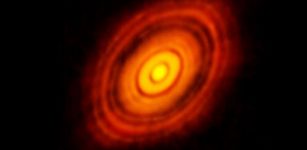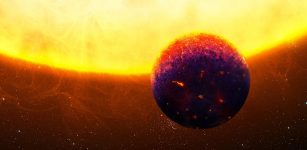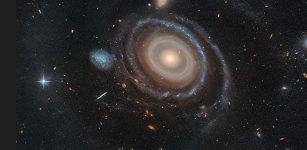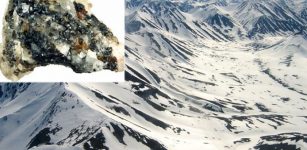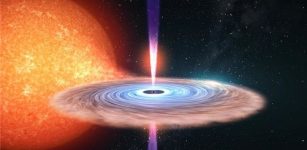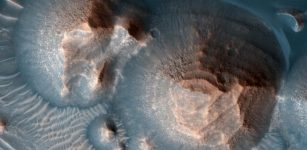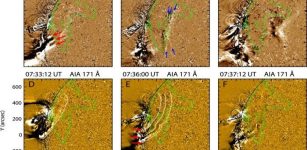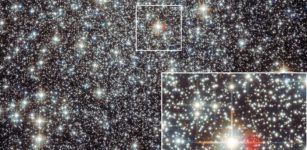Unique Planet Orbiting Three Suns Discovered In The Orion Constellation
Eddie Gonzales Jr. – MessageToEagle.com – It’s too early to say anything yet with certainty, but astronomers may have discovered for the first time a planet-forming disk with misaligned rings around a triple star system!
The planet located in the Orion constellation orbits three suns at once! Anything like this has never been observed before, but why is it misaligned?
Astronomers give two possible scenarios for the misalignment: either the disk was torn apart by the gravitational pull from the stars, or by a newborn planet.

Orion constellation. Credit: Public Domain
Most stars that look like our Sun are born with siblings. Unlike the planets in our Solar System, which all orbit in the same plane around the Sun, planets around these multi-star systems often have orbits that are not aligned with the orbits of their stars.
Their crooked orbits originate in the planet-forming disks, the birthplaces of planets.
Studying misaligned disks around multiple stars therefore helps us understand how these planets form. Previously ALMA imaged the misaligned disks in the ‘Tatooine’ binary star system.
This fascinating discovery was made by two independent teams of astronomers who pointed ALMA at GW Orionis, a young star system hosting three stars. The inner stars GW Ori A and B orbit each other and are separated by 1 au, and the third star GW Ori C orbits its two siblings at a distance of roughly 8 au.
ALMA found three separate rings with different orientations in the massive planet-forming disk of GW Orionis, located roughly 46, 185, and 340 au from its center. The inner ring is very misaligned relative to both the outer rings and the three stars. The outermost ring is the largest ever observed in planet-forming disks. If a planet would be forming in the gap between the inner and outer ring, it would be located incredibly far away from the stars. For comparison, Neptune is only about 30 au from the Sun.

ALMA images of the planet-forming disk with misaligned rings around triple star system GW Orionis. Credit: ALMA (ESO/NAOJ/NRAO), S. Kraus & J. Bi; NRAO/AUI/NSF, S. Dagnello
“We were surprised to see the strong misalignment of the inner ring. But the strange warp in the disk is confirmed by a twisted pattern that ALMA measured in the gas of the disk,” said Jiaqing Bi of the University of Victoria in Canada
The second team of astronomers, led by Stefan Kraus from the University of Exeter in the UK, pointed both ALMA and the European Southern Observatory’s Very Large Telescope (VLT) towards the triple stars. His team detected warm gas at the inner edge of the misaligned ring and scattered light from the warped surface of the disk.
“In our images, we see the shadow of the inner ring on the outer disk. At the same time, ALMA allowed us to measure the precise shape of the ring that casts the shadow. Combining this information allows us to derive the 3-dimensional orientation of the misaligned ring and of the warped disk surface,” said Kraus, whose team published their results in Science today.
Scientists have performed computer simulations to investigate what could possibly cause the inner ring to be misaligned from the rest of the disk and the stars.
Astronomers link the observed misalignments to the ‘disk-tearing effect’, which suggests that the gravitational pull of stars in different planes can warp and break their disks. Their simulations showed that the misalignment in the orbits of the three stars could cause the disk around them to break into distinct rings.

Representation of the disc structure and stellar orbit of the GW Orionis triple system, as derived from the ALMA and VLT observations by Kraus et al. Orange rings are the (misaligned) rings seen by ALMA. The transparent surfaces correspond to the lower-density dust filaments that connect the rings and that dominate the emission in scattered light. Credit: Kraus et al., 2020; NRAO/AUI/NSF
“Our simulations show that the gravitational pull from the triple stars alone cannot explain the observed large misalignment. We think that the presence of a planet between these rings is needed to explain why the disk was torn apart,” said team member Nienke van der Marel of the University of Victoria.
“This planet has likely carved a dust gap and broken the disk at the location of the current inner and outer rings,” she added.
Kraus also speculates about planets in GW Orionis: “The inner ring contains enough dust to build 30 Earths, which is sufficient for a planet to form in the ring.”
If future studies find this exotic planet – whether it already exists or is still forming – it would be the first planet ever observed to orbit three stars, and it would possess a very unusual orbit.
Written by Eddie Gonzales Jr. – MessageToEagle.com Staff

